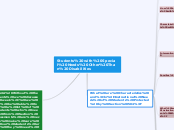Students with Special Needs Other Than Disabilities
What are Characteristics and
Instructional Needs of Students Protected by Section 504?
Understanding Section 504
Any condition that substantially limits
a major life activity is defined as a disability
Section 504 does not provide funds to
school districts to carry out its requirements
It expects schools to take whatever steps
necessary, even if additional funds are
required, to eliminate discrimination
Students Eligible for Services under Section 504
Students with chronic health or medical problems
Students with learning problems
Anyone who qualifies for a disability may
receive services through Section 504
How Can You Accommodate Students with ADHD?
ADHD-predominantly inattentive type:
They appear to daydream but don't tend
to wiggle any more than their peers.
ADHD-predominantly hyperactive-impulsive type:
These students physically move far more than
their peers.
ADHD- combined type:
Students in this group display the characteristics
of both of the other types of ADHD. They experience extraordinary difficulty both in focusing their attention and in restricting their movement.
Characteristics and Needs of Students with ADHD
Working Memory- the ability to remember
what tasks are supposed to be done and how
much time there is to do them
Self-directed speech- the silent self-talk that most people use to manage complex tasks
Control of emotions and motivation-
the ability to talk oneself into calming
down when faced with a difficult or
frustrating task
Reconstitution- the ability to combine skills
learned across a variety of settings in order
to carry out a new task, such as a student's
knowledge that the rule for speaking in a low
voice applies not only in the classroom, but
everywhere else
Interventions for Students with ADHD
Environmental Supports
Academic Interventions
1. emphasize essential information
2. when reading for comprehension,
use shorter passages
3. in math, give students extended
periods of time because they struggle
with efficiency
Behavior Interventions
Parent Education
Medication
4. keep the pace lively during large-
group instruction
Families of Children with ADHD
Be careful not to blame parents for their children's ADHD
Parents and family members are faced with responding to these children's emotions and potentially harmful behaviors
What Are the Characteristics and Instructional Needs of
Students Who Are Gifted and Talented?
These are students with extraordinary abilities and skills
Gardner's 8 intelligences:
verbal/linguistic
visual/spacial
logical/mathematical
bodily/kinesthetic
musical
intrapersonal (self-understanding)
Assess your student and see where out of these
intelligences these students need a challenge
interpersonal
naturalist
existentialist
Characteristics and Needs of Students Who Are Gifted and Talented
Intellectual abilities and academic skills
Social and emotional needs
behavior patterns
Interventions for Students Who Are Gifted and Talented
Curriculum Compacting
Acceleration
Enrichment
Differentiation
Specialized Interventions
What are the Characteristics and Instructional Needs
of Students from Culturally Diverse Backgrounds?
Diversity and Special Education
Cultural Awareness
Cultural Factors and Student Behavior
Informed Instructional Decision Making
Cross-Cultural Communication
We need to be making sure that our assessments
are not discriminatory and that they are accurate
What are the Characteristics and Instructional Needs of Students Who Are at Risk?
The strategies for accommodating the needs of students with disabilities are usually effective for students at risk. By using the INCLUDE strategy, you can identify ways to help these students reach their potential
Effective early school experiences for students who are at risk, increasingly based on RtI processes, can establish a pattern of success in school learning that carries through high school. Without such experiences, students at risk are more likely to be identified as having learning or emotional disabilities
Many students with disabilities also are students at risk. Many students with disabilities have bee abused, some live in poverty, and others use illegal drugs
Characteristics and Needs of Students at Risk
Students who live in poverty
Students who are abused or neglected
Students who live with substance abuse or are substance abusers
Subtopic
Interventions for Students at Risk
Set high but realistic expectations
establish peers as teaching partners
collaborate with other professionals
support family and community involvement
